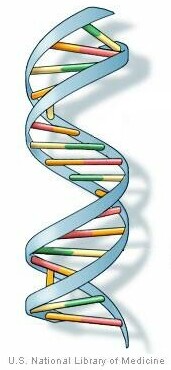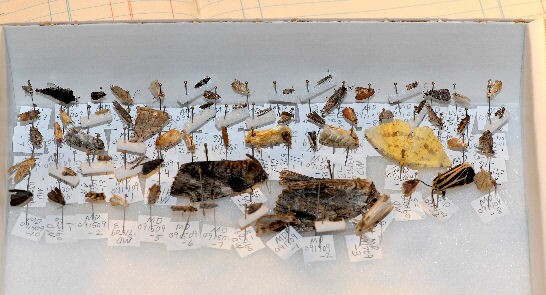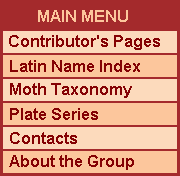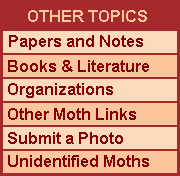Contributing to BOLD — DNA Research
by Bob Patterson
It was announced in May of 2012 that, due to budget constraints, BOLD would be unable to continue offering free barcoding service to individual collectors and photographers. In essence, future barcoding of lepidoptera will be limited to institutions meeting certain requirements of specimen volume and financial support. Please ignore the suggestions at the bottom of this page for contacting BOLD. This notice will be removed if BOLD is able to again offer this service.
|


Participating in DNA research is not for everyone. But if you are an avid photographer of moths you can do yourself and science a favor by contributing moth DNA to the research program at the Biodiversity Institute of Ontario (BIO).
Based at the University of Guelph, BIO is the world leader in the use of DNA barcoding for identification and discovery of species. It has developed high-throughput laboratory protocols for DNA sequencing and is the biggest contributor to BOLD (Barcode of Life Data Systems) – the online database and workbench for the global barcode community. A great deal of overview information can be gleaned at the BIO and Bold websites.
Moth photographers quickly learn that identifying moths in photographs can in many cases be very difficult. There are numerous reasons why this is so. Some of the principal reasons include:
- Our photograph libraries are not yet robust enough to show all species in all their variations.
- Many species are so similar that they can't be identified by external markings or coloration.
- Specialists who might be able to make identifications have little time for viewing photographs.
- Many species can be identified only by examination of genitalia or by DNA analysis.
At the expense of a small amount of time per photograph/specimen photographers can contribute to DNA barcode research, receiving in return positive DNA-based identifications for a high percentage of the moths photographed. The necessary record keeping is minimal and no special training or skill is required to prepare specimens for shipment to Guelph using material supplied by BIO. Here are the basics regarding how the program operates.




Two kinds of DNA are found in most cells. There is the single whole genome or nuclear DNA molecule found in the cell nucleus (of most cell types), and the much smaller mitochondrial DNA molecule (usually written as mtDNA) found in the many mitochondria in cells.
The DNA barcode uses a 658 base pair segment of mtDNA, taken from the COI region, for analyses of moths and other animals. By clicking on either of the photographs shown here you will be taken to more detailed originals on the Internet. The mtDNA photo on the left will bring up an article giving a nice explanation about mtDNA.
At BIO the highly trained technical staff use very sophisticated equipment and computer programs to transcribe the mtDNA and compare the resulting string of up to 658 letters (in some cases, particularly in older specimens, less than 100% of the DNA can be transcribed). The transcribed DNA is then processed against a database to find the closest matches among known species. Once this is accomplished the results are posted to the BOLD database accessible to contributors of specimens and to researchers around the world. Examples of these results are shown below.
While we are here discussing only adult moths and the benefits to BIO/BOLD and photographers/collectors, in the near future the program will also encompass the decoding of DNA for the identification of larvae.
Reference Specimens. In order for the BOLD system to work there must be in the database the DNA from well confirmed reference specimens. These will usually be specimens previously identified by experts after examination of genitalia. Reference specimens have been gathered from collections at Mississippi Entomological Museum, the U.S. and Canadian National Collections and from many other museums and private collections. However, it is very difficult to obtain complete transcriptions of 658bp of mtDNA from specimens more than 10 years old. For many of our 11,000 North American moth species more recent fresh material is simply not to be found in collections.
This is where contributions from photographers can be extremely valuable, not only because your specimens are fresh but also because they will often be representative of geographical variation within species. If you are attempting to do a thorough survey of the moths that visit your property it is quite likely that you will encounter, especially among the micromoths, species that are "new" to the BOLD DNA collection effort. When such specimens are discovered (perhaps identified at BOLD only at the family or genus level) they will be sent to experts for proper identification. Thus, it is very possible that some of your moths may end up serving as the "gold standard" reference specimens in the BOLD database and at GenBank.
DNA research is not for everyone. There are very large costs involved in operations at BIO and BOLD which can be kept to a minimum only through economies of scale. These costs are far different when processing 100-200 specimens received in one package from an established contributor ($5-$10 per specimen) vs. what they would be if just a few specimens were received from each of 20-30 contributors. So, as a practical matter, photographers who wish to participate in the BIO/BOLD program ought to be those who are in the hobby in a very serious way, expecting to spend several years in documenting the 1,000-1,200 species that visit their property.
What You Might Expect from BOLD. Mark Dreiling lives in Bartlesville, Oklahoma and I will use his experience with BOLD as a kind of prospectus for moth photographers. Many of Mark's photographs displayed at Moth Photographers Group, or his Images at BugGuide.Net and at his Galleries at PBase reveal his contributions to BOLD and his indebtedness to that program for providing solid identifications for moths that would otherwise have remained unidentified or would at best have been identified only tentatively or at the level of genera or families.
As I write this in early January of 2010 I can see at BOLD (Mark granted permission for me to view his data there) that Mark has contributed 3,715 specimens collected between 23-Aug-2008 and 09-Nov-2009 and has already received identifications that include 732 species. His latest "project" remains largely yet to be processed. BOLD groups for data collection and reporting approximately 1,000 specimens into labeled projects. Three of Mark's projects are largely completed, but work proceeds on the latest project (LPOKD - Bartlesville 4). Each of the first three projects happened to include about 380 species, some of them repeated in other projects. His cumulative number of species to date (732) is reported elsewhere in BOLD.

BOLD offers contributors numerous ways for viewing their data. The next graphic shows the beginning of the listing for Mark's specimens from project LPOKA in alphabetic order of species. The report can be sorted on any column with a red arrow in the heading. Under Specimen Page one sees Mark's specimen numbers as they were assigned and logged in by BOLD. Under Sequence Page is shown the BOLD system identifier for the DNA sequence that was produced. Notice that for the specimen of Acontia aprica less than the full complement of 658bp of DNA was transcribed.

Sorting the file by Mark's specimen page numbers shows that his first specimen collected for BOLD was determined to be of Acronicta retardata, a moth we shall follow through the reporting. By clicking on a specimen page he will be able to see certain kinds of data, including a photograph, related to that moth. Other kinds of data will be available from the sequence page for the same moth.

Two kinds of data may not be of much interest to photographer hobbyists, but the actual transcription of the DNA is presented as the four nucleotides adenine, thymine, cytosine and guanine, abbreviated A, T, C and G. The colorful photo below that shows the actual barcode, just a longer version of what you see on products that are scanned at the supermarket or bookstore.


One listing shows the closest 20 matches in the BOLD database. This can of course change over time as more specimens are added to the database. In this partial version of the "top twenty" all but one of the matches have been identified as Acronicta retardata. The single exception probably needs only the intervention of a staff specialist to complete the filling in of data. Matches of 99% or higher are almost always of the same species.

Finally we come to my favorite graphic, the presentation of specimens in a cladogram which shows the close relationship among other specimens of the same species and the distance from other species (cropped out of this photograph). The "unknown specimen" in red is used to draw the eye to the section of the cladogram in which the target specimen "LPOKA001-08" will be found. That specimen nests tightly with two others from Mark's property. The cladogram permits us to see other clumpings of moths with minor DNA differences, probably from other parts of the range of the species. Item [21] in the list is probably the specimen with incomplete data in the previous listing.

What BOLD Might Expect from You. If you are accepted as a contributor, BIO will send you shipping containers and pins (three sizes of pins if you will include your smaller micromoths). When you have filled a shipping container you send it to them and they will reimburse the shipping expense (unless you wish to consider that a donation also). The photographs below are taken from a BugGuide Forum Page initiated by Mark Dreiling. The start of a box of specimens is shown here. The specimens are arranged in chronological order for the benefit of the technicians at Guelph. Very large moths have a couple of large pins crossed over to keep them from getting loose and damaging the others during shipment.
 
The smaller photo shows two pinned specimens. The micro moth on the left has been attached with a minuten pin to a foam strip which is then pinned, with a larger standard pin, through the .5" x .5" label cut from card stock paper. The moth on the right is typical of larger moths. All of these moths have been "field pinned." There is no need for you to produce fully spread specimens. Notice that, because all of Mark's moths come from a single location his labeling is very simple: initials, date and sequence number for that date. All of his geographic data (address, coordinates, elevation) that would normally go on a specimen label are repetitive and were registered by BOLD at the time he was accepted as a contributor .
It was announced in May of 2012 that, due to budget constraints, BOLD would be unable to continue offering free barcoding service to individual collectors and photographers. In essence, future barcoding of lepidoptera will be limited to institutions meeting certain requirements of specimen volume and financial support. Please ignore the suggestions at the bottom of this page for contacting BOLD. This notice will be removed if BOLD is able to again offer this service.
|
Getting Started with BOLD. Send an email to Paul Hebert giving details of your location, the extent of your photography, and perhaps your plans for the future. You can provide links to your photo collections at MPG, BugGuide or elsewhere. Allow several weeks to hear back from Paul Hebert. He has to travel a lot and may be out of the office for a period of time, but he will certainly get back to you.
Keep in mind that the specimens that you contribute to BOLD can and should serve several purposes. First, your original photograph should be as good as you can make it (you don't have to have fancy equipment or be an expert photographer). The photograph should end up in one or more online collections with the notation "Identification supported by DNA at BOLD". It should be able to aid others in identifying their moths. Secondly, the specimen itself should be a nice one, not something that is tattered, worn and torn. It will end up in a research collection, available to future investigators, and should be as useful as possible.
Plan to do a little record keeping. Have a supply of capture vials available (prescription medicine containers work well, you can probably get a supply in several sizes from your pharmacist at little cost). Photograph a moth, freeze it, pin it and store it for shipment. Record for each moth the date, sequence and size (forewing length, to be reported when posting the photograph to the Internet) and label your photographs to match the specimen records. You can keep records in a notebook or use a computer spreadsheet. You don't want to have any problem in matching your photographs to the DNA data at BOLD. It may be several months before the DNA data are available and you can't trust things to memory.
Happy Mothing!
|














